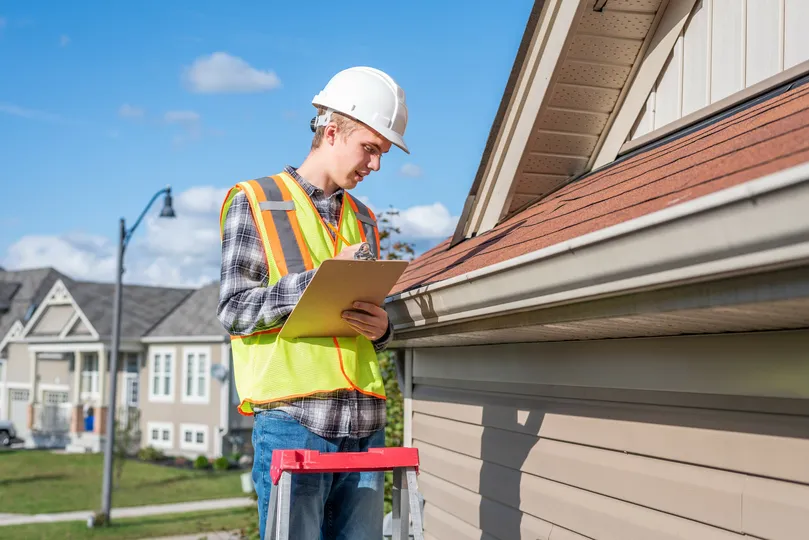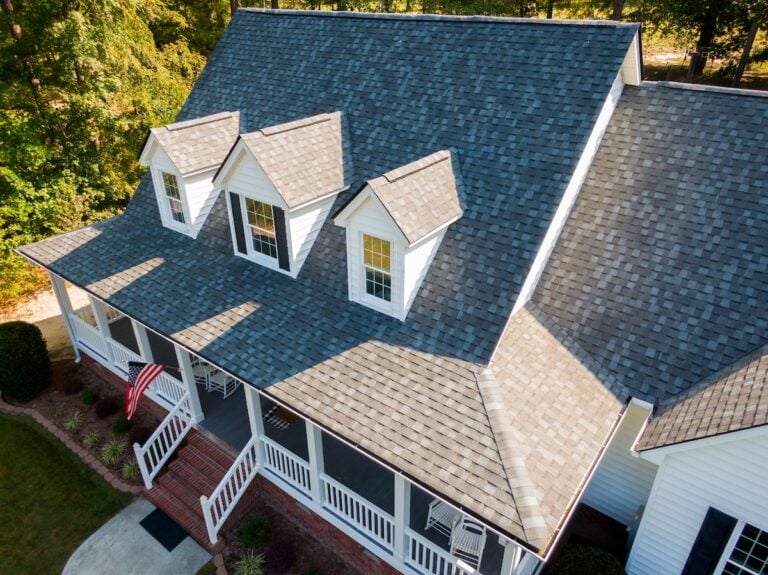Hailstorms can wreak havoc on your roof, leaving behind damage that can compromise its integrity and lifespan. While some signs of hail damage are obvious, others can be more subtle, requiring a keen eye to detect. This comprehensive guide will help answer the question, “What does hail damage look like on a roof?” and what signs to look out for to ensure your roof remains in good condition, including some of the following categories:
- Metal Surfaces
- Shingle Issues
- Roof Structure and Components
- Moisture and Environmental Damage
- Maintenance and Inspection
⚠️ 25 Signs of Hail Damage
Hailstorms can cause significant damage to your roof, often going unnoticed until it’s too late. Identifying the signs of hail damage early on is essential to prevent long-term issues and costly repairs. In this section, we’ll outline 25 key indicators that your roof may have been compromised by a hailstorm.
1. Dents and Dings on Metal Surfaces
One of the most apparent signs of hail damage is dents or dings on metal surfaces. This includes metal flashing, vents, gutters, and downspouts. Hailstones, depending on their size and velocity, can leave noticeable indentations on these surfaces.
- Check metal flashing for dents.
- Inspect vents, gutters, and downspouts for dings.
When inspecting your roof, look for any irregularities or deformations in the metal components.
2. Bruising on Shingles
Bruising occurs when the impact of hailstones displaces the granules on asphalt shingles, causing a soft spot or bruise. To check for bruising, gently run your hand over the surface of the shingles. If you feel any soft spots or indentations, this is likely a bruise. Over time, bruised shingles can deteriorate further, leading to leaks and other issues.
3. Granule Loss
Granules on asphalt shingles protect the underlying material from UV rays and weathering. Hailstorms can knock these granules loose, leading to significant granule loss. This is often visible as bald spots on the shingles or granules accumulating in your gutters and downspouts. If you notice a large number of granules in your gutter system after a hailstorm, it’s a strong indicator of hail damage.
4. Cracks in Shingles
Hailstones can cause cracks in shingles, especially if they are large or if the shingles are older and more brittle. These cracks can vary in size and may be straight or jagged. Cracked shingles can expose the roof deck to moisture, leading to leaks and water damage. Inspect your roof for any visible cracks and consider replacing any damaged shingles promptly.
5. Damage to Roof Vents and Skylights
Roof vents and skylights are particularly vulnerable to hail damage due to their exposed position. Check for cracks, dents, or other damage to these components. Skylights may have cracks in the glass or damage to the flashing around them. Damaged vents can lead to improper ventilation, which can affect the overall health of your roof.
6. Shingle Mat Exposure
Hailstones can dislodge the protective granules and expose the shingle mat beneath. This exposure can be identified by looking for dark spots or areas where the granules are missing. Shingle mat exposure significantly reduces the lifespan of your shingles and can lead to more severe issues if not addressed.
7. Damaged Roof Flashing
Flashing is used to seal and protect areas of the roof that are prone to leaks, such as around chimneys, vents, and skylights. Hail can cause flashing to become dented, bent, or even torn. Damaged flashing can lead to water infiltration, so it’s essential to inspect these areas carefully after a hailstorm.
8. Splits in Wooden Shingles or Shakes
For roofs with wooden shingles or shakes, hail damage can manifest as splits or cracks in the wood. These splits may be accompanied by discoloration or a frayed appearance at the edges. Split shingles can compromise the roof’s ability to shed water effectively, leading to leaks and rot.
9. Shingle Displacement
In severe hailstorms, shingles can become displaced or completely torn off the roof. Missing shingles leave the roof deck exposed to the elements, increasing the risk of water damage. After a hailstorm, inspect your roof for any missing or displaced shingles and arrange for immediate repairs if needed.
10. Mold or Mildew Growth
Hail damage can create openings in your roof that allow moisture to penetrate. Over time, this moisture can lead to the growth of mold or mildew, which can spread to other areas of your home. Look for any signs of mold or mildew on your roof, especially in areas that seem to retain moisture.
11. Water Stains on Ceilings or Walls

Interior water stains can be a telltale sign of roof damage caused by hail. If you notice water stains on your ceilings or walls, it’s likely that hail has compromised the integrity of your roof, allowing water to seep through. Investigate the source of the leak and have it repaired as soon as possible to prevent further damage.
12. Curling or Buckling Shingles
Hail damage can cause shingles to curl or buckle, particularly if the impact is strong enough to break the adhesive bond. Curling shingles can catch the wind and become dislodged more easily, increasing the risk of further damage. Inspect your roof for any shingles that appear to be lifting or curling.
13. Compromised Roof Ridge Caps
The ridge cap is the topmost part of the roof where two slopes meet. It is particularly vulnerable to hail damage. Look for cracks, dents, or missing pieces on the ridge cap. Damage to this area can compromise the overall structure of the roof and should be repaired promptly.
14. Indentations on the Roof Surface
In addition to dents in metal components, hail can cause indentations in the roof surface itself. These indentations may not be immediately obvious, but they can lead to pooling water and eventual leaks. A thorough inspection of the roof surface can help identify these subtle signs of damage.
15. Damaged Gutters and Downspouts
Hail can cause significant damage to gutters and downspouts, leading to dents, cracks, and even detachment from the roofline. Damaged gutters can result in improper drainage, which can affect the overall health of your roof and foundation. Check your gutter system for any signs of damage and ensure they are functioning correctly.
16. Chimney Damage
Chimneys can also suffer damage from hail, particularly the flashing and brickwork. Inspect the chimney for any cracks, missing mortar, or damage to the flashing. Chimney damage can lead to leaks and structural issues if not addressed.
17. Loose or Missing Shingle Granules
After a hailstorm, it’s common to find loose granules on the ground around your home or in the gutter system. While some granule loss is normal, an excessive amount can indicate hail damage. Regularly check for loose granules and consider a professional inspection if you notice a significant amount.
18. Discoloration of Shingles
Hail impact can cause discoloration of shingles, particularly if the protective granules are knocked off. This discoloration may appear as dark spots or streaks on the roof surface. Discolored shingles can indicate underlying damage and should be inspected further.
19. Soft Spots on Roof Decking
Walking on your roof can help identify soft spots that may have resulted from hail damage. Soft spots can indicate weakened areas of the roof decking, which can lead to more severe structural issues if not repaired. Be cautious when walking on your roof, and consider hiring a professional for a thorough inspection.
20. Blistering Shingles
Blistering occurs when moisture trapped within the shingles heats up and causes the shingle to bubble. Hail damage can exacerbate this issue by further compromising the shingle’s integrity. Blistered shingles can lead to leaks and should be replaced promptly.
21. Damage to Solar Panels or Other Roof Equipment
If you have solar panels or other equipment installed on your roof, they can also be damaged by hail. Check for cracks, dents, or other signs of damage to these components. Damaged equipment can affect the performance and efficiency of your roof system.
22. Ice Damming
Hail damage can contribute to ice damming in colder climates. Ice dams occur when melted snow refreezes at the roof’s edge, preventing proper drainage. This can lead to water backing up under the shingles and into the roof deck. Inspect your roof for signs of ice damming, such as icicles or ice buildup along the eaves.
23. Debris Accumulation
Hailstorms often come with high winds that can blow debris onto your roof. This debris can cause additional damage, block drainage systems, and retain moisture. After a hailstorm, clear any debris from your roof and gutters to prevent further issues.
24. Worn Sealant or Caulking
The impact of hailstones can wear down sealant or caulking around roof penetrations, such as vents and skylights. Check these areas for any signs of deterioration and reapply sealant as needed to maintain a watertight seal.
25. Professional Roof Inspection

While many signs of hail damage can be identified through a visual inspection, some damage may be more difficult to detect. It’s advisable to have a professional roofing contractor conduct a thorough inspection after a hailstorm. They have the expertise and tools to identify even the most subtle signs of damage and can provide recommendations for repairs or replacement.
🙌 Protect Your Roof from Hail Damage with Best Exteriors
Hail storm damage can significantly affect the integrity and lifespan of your roof. At Best Exteriors, our experienced team is expertly trained to identify and address all signs of hail damage, from dented metal and bruised shingles to damage on roof accessories. By conducting thorough inspections and providing prompt repairs, we help protect your home and save you time, money, and stress in the long run.
Trust Best Exteriors to safeguard your roof and ensure the safety and comfort of your home for years to come. If you suspect hail damage, don’t wait—contact us today for a comprehensive inspection and a tailored repair plan. Your home’s protection starts with Best Exteriors!




